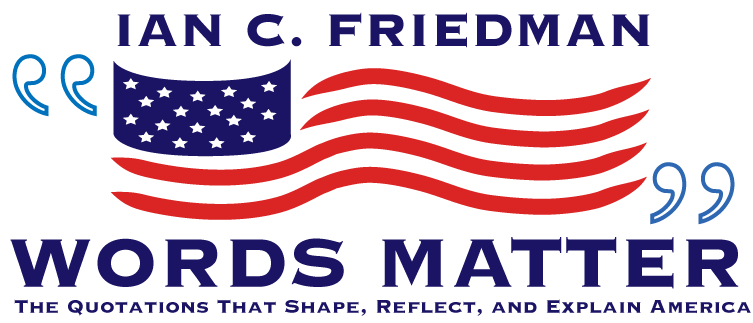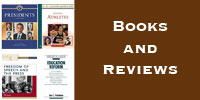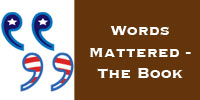“We hold these truths to be self evident…” – Thomas Jefferson, July 4, 1776
Thomas Jefferson was under enormous pressure and unyielding time constraints when he first sat down at a small portable desk that he had designed himself and began writing what would become known as the Declaration of Independence.
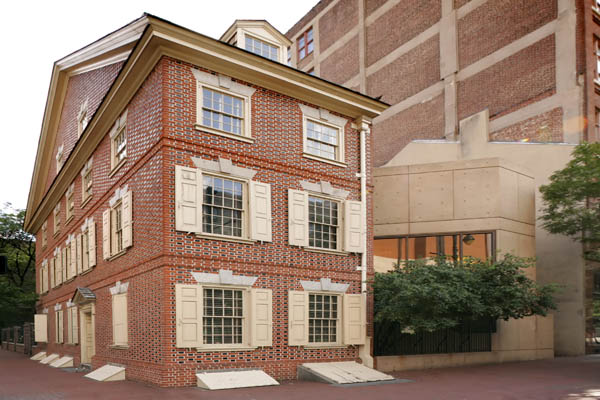 Outside of the rented second-floor parlor of a bricklayer’s house in downtown Philadelphia where the tall, quiet, thirty-three-year-old Jefferson worked, the prospects for the movement of American independence were suspect at best. British ships were preparing to attack near New York Harbor and Charleston, South Carolina. Fledgling American forces, plagued by sickness and lacking sufficient supplies, were hurriedly beating a retreat and planning their defense.
Outside of the rented second-floor parlor of a bricklayer’s house in downtown Philadelphia where the tall, quiet, thirty-three-year-old Jefferson worked, the prospects for the movement of American independence were suspect at best. British ships were preparing to attack near New York Harbor and Charleston, South Carolina. Fledgling American forces, plagued by sickness and lacking sufficient supplies, were hurriedly beating a retreat and planning their defense.
Understanding that failure to persuade reluctant leaders of the need to break free from Great Britain would irreparably harm the chances for independence and would almost certainly lead to the patriots’ execution for treason, Jefferson sought to make the declaration an “expression of the American mind.” To do this, he combined his lively scholarly intellect and prodigious writing talent with ideas drawn from some of the most influential philosophical and political documents of his time. Jefferson found a model in the theories of seventeenth-century English philosopher John Locke, who put forth the radical belief that people are born with certain natural rights and that governments should be organized for the benefit of everyone, not just the rulers.
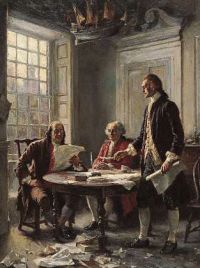 Working quickly yet with painstaking attention to detail, Jefferson composed numerous drafts of the Declaration before sharing his work with his fellow draft committee members John Adams and Benjamin Franklin. They suggested additional revisions before the document was finally submitted to the Second Continental Congress on June 28, 1776. For three days the Congress scrupulously reviewed the draft, and the reserved Jefferson sat uneasily as nearly one hundred changes were made to his composition. Finally, on July 4, 1776, the Declaration of Independence was unanimously approved.
Working quickly yet with painstaking attention to detail, Jefferson composed numerous drafts of the Declaration before sharing his work with his fellow draft committee members John Adams and Benjamin Franklin. They suggested additional revisions before the document was finally submitted to the Second Continental Congress on June 28, 1776. For three days the Congress scrupulously reviewed the draft, and the reserved Jefferson sat uneasily as nearly one hundred changes were made to his composition. Finally, on July 4, 1776, the Declaration of Independence was unanimously approved.
The Declaration’s sweeping expression in favor of human rights and against tyranny appears in its second paragraph:
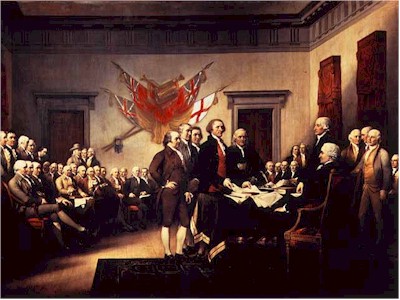 “We hold these truths to be self-evident, that all men are created equal, that they are endowed by their Creator with certain unalienable rights, that among these are life, liberty and the pursuit of happiness—That to secure these rights, Governments are instituted among Men, deriving their just powers from the consent of the governed, that whenever any Form of Government becomes destructive of these ends, it is the Right of the People to alter or to abolish it, and to institute new Government.”
“We hold these truths to be self-evident, that all men are created equal, that they are endowed by their Creator with certain unalienable rights, that among these are life, liberty and the pursuit of happiness—That to secure these rights, Governments are instituted among Men, deriving their just powers from the consent of the governed, that whenever any Form of Government becomes destructive of these ends, it is the Right of the People to alter or to abolish it, and to institute new Government.”
A series of detailed charges of tyranny against King George III followed. The charges represented a stunning departure from previous colonial complaints, which had been lobbed largely at the British Parliament or the king’s ministers—and only after a clear disclaimer regarding loyalty to the monarch. The Declaration of Independence attacked the king directly, accusing him of such offenses as “imposing taxes without our consent,” “depriving us in many cases of . . . trial by jury,” “abolishing our most valuable laws,” “suspending our own legislatures,” and “waging war against us.”
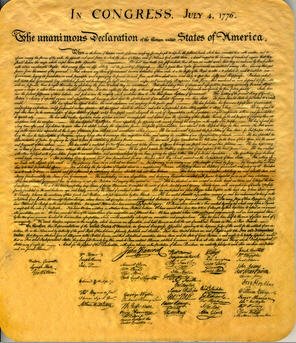 The Declaration built the case that because of King George III’s abuse of power there was no reasonable alternative to revolution. Its emphasis on the importance of the “consent of the governed” provided a powerful argument not only against the British king but also against what was viewed as the inherently disconnected, corrupt, and unaccountable authority of monarchies themselves. The document specifically embraced two radical convictions: that a person’s position should be determined not by rank or title but by talent and ability, and that governments that do not enjoy the support of the people can and should be replaced by the people.
The Declaration built the case that because of King George III’s abuse of power there was no reasonable alternative to revolution. Its emphasis on the importance of the “consent of the governed” provided a powerful argument not only against the British king but also against what was viewed as the inherently disconnected, corrupt, and unaccountable authority of monarchies themselves. The document specifically embraced two radical convictions: that a person’s position should be determined not by rank or title but by talent and ability, and that governments that do not enjoy the support of the people can and should be replaced by the people.
Yet the Declaration’s enduring legacy of an expanded definition of equality and liberty is tainted by the fact that the man who wrote it owned over two hundred slaves. Jefferson, a wealthy Virginia planter, lawyer, and architect, was a man of his time and place, subject to the widespread prejudices according to which people of African descent were viewed as inferior and not worthy to enjoy the benefits of freedom proclaimed in the Declaration.
Nevertheless, in his draft of the Declaration, Jefferson, who had elsewhere described slavery as an “abominable crime” that must eventually be stopped, included among the grievances the charge that the king had “waged a cruel war against human nature” by assaulting a “distant people” and “captivating and carrying them into slavery into another hemisphere.” However, this passage had offended most southern delegates to the Second Continental Congress, as well as some northern delegates who represented merchants who had become wealthy in the slave trade. The antislavery provision was deleted in a political compromise that foreshadowed decades of conflict and accommodation over slavery.
At the time the Declaration of Independence was created, its legacy as a commanding source of genuine American moral authority for those who seek to hold the historic document to its promise was only beginning to take shape. But its immediate impact was clear and profound. Beyond giving birth to a new nation—the United States of America—the words of the Declaration of Independence also inspired resolve and unity among a diverse collection of people who no longer considered themselves primarily as British subjects, colonists, Virginians, or New Yorkers. They were Americans.
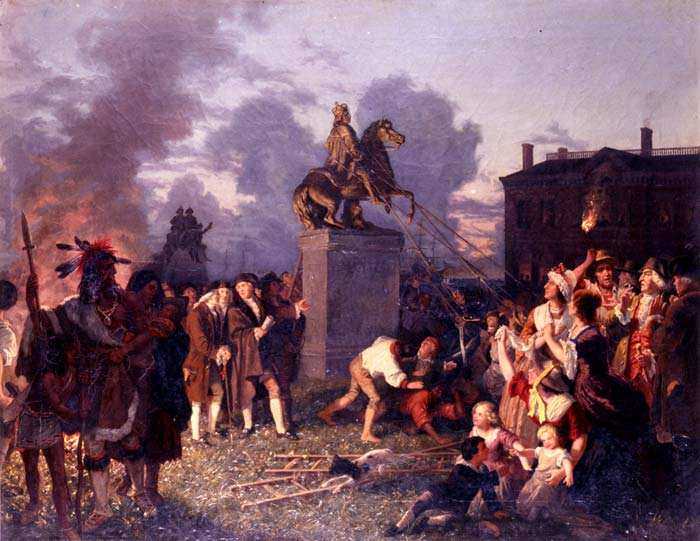 Copies of the Declaration of Independence were quickly printed and carried to colonial towns, where its words were cheered with great enthusiasm. On July 9, 1776, General George Washington and his troops heard the Declaration read in New York City. Later that evening, a raucous crowd pulled down a gilded statue of King George III. The metal from this toppled sculpture was later melted and forged into thousands of bullets, which were ultimately fired against the forces of the British monarchy by the patriot soldiers of the American Revolution.
Copies of the Declaration of Independence were quickly printed and carried to colonial towns, where its words were cheered with great enthusiasm. On July 9, 1776, General George Washington and his troops heard the Declaration read in New York City. Later that evening, a raucous crowd pulled down a gilded statue of King George III. The metal from this toppled sculpture was later melted and forged into thousands of bullets, which were ultimately fired against the forces of the British monarchy by the patriot soldiers of the American Revolution.
